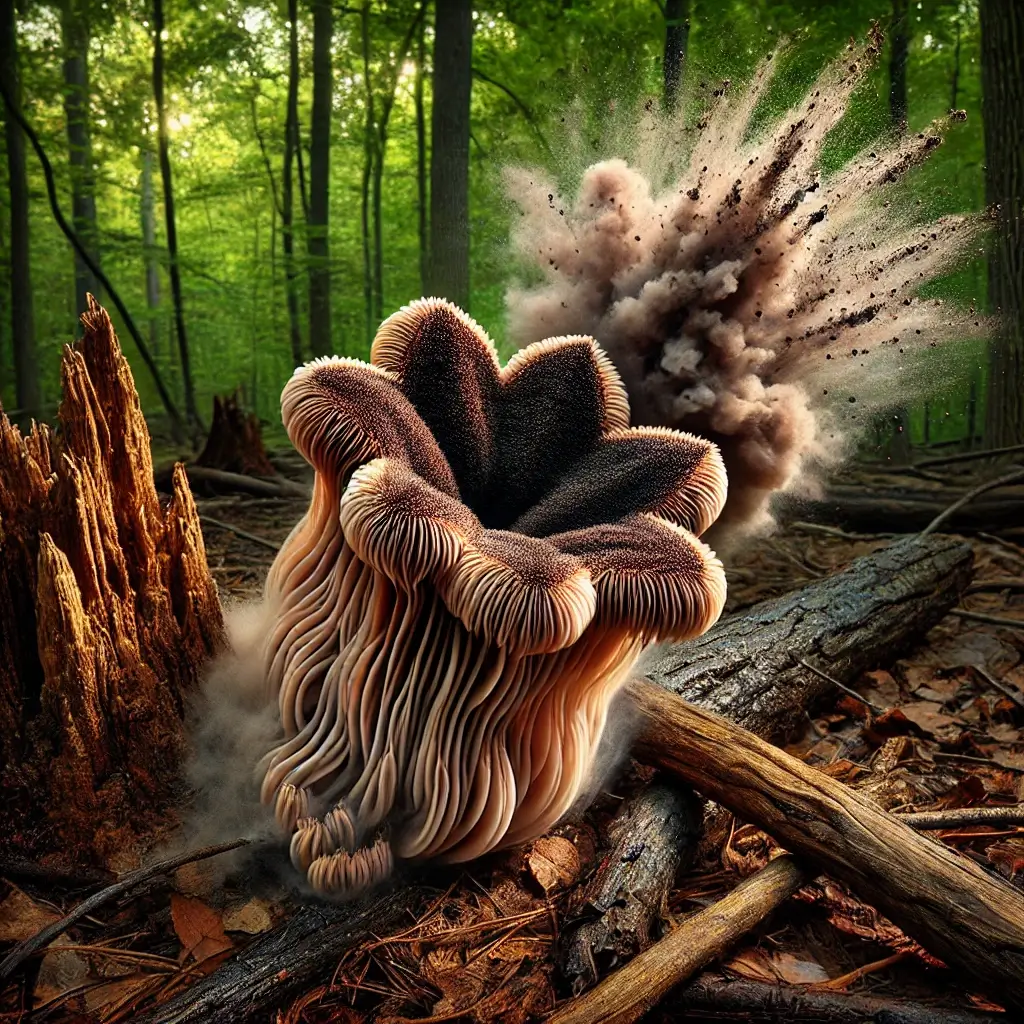Discovering Nature’s Rarest Fungal Wonder
Amid the vast diversity of fungi, the rare hissing mushroom (Chorioactis geaster), commonly known as the Texas Star Mushroom, stands as a unique and fascinating species. Found sporadically in North and Central Texas, Oklahoma, and parts of Japan, this mushroom’s life cycle and characteristics are unparalleled. Its dark, cigar-like appearance transforms dramatically into a star-shaped structure post-rain, earning it the nickname “Devil’s Cigar.” Such a transformation is not only visually captivating but also indicative of its complex ecological adaptations.
The Extraordinary Spore Dispersal Mechanism
What truly sets the Texas Star apart is its unusual spore dispersal mechanism. Following heavy rains, this mushroom opens with an audible hissing sound, releasing a visible cloud of spores. This rare feature, resulting from a build-up of internal pressure, has fascinated mycologists and ecologists for decades. The hissing mushroom’s dramatic lifecycle offers valuable insights into fungal evolution, adaptation, and ecosystem functionality.
Ecological Significance and Conservation Concerns
Despite its dramatic presence, sightings of the Texas Star are exceptionally rare, attributed to its specific habitat requirements. It thrives on decaying cedar elm stumps, requiring precise soil, moisture, and climatic conditions for growth. This rarity, combined with its ecological importance, makes it a species of high conservation interest. The Texas Star Mushroom serves as a compelling example of the intricate relationships that fungi maintain within ecosystems, showcasing the balance necessary for biodiversity.
Groundbreaking Scientific Discoveries
Recent studies have deepened our understanding of the Texas Star Mushroom, unraveling its complex life cycle and ecological contributions. A 2023 study published in Mycological Research explored its unique spore dispersal mechanism. Researchers identified that its explosive spore release is triggered by shifts in moisture and air pressure, ensuring dispersal even in suboptimal conditions. This evolutionary adaptation highlights fungi’s resilience and intricate ecological strategies.
International Collaborative Research
In 2024, collaborative research between Kyoto University and the University of Texas delved into the genetic diversity of Chorioactis geaster. The study revealed genetic similarities between Texan and Japanese populations, suggesting a shared evolutionary lineage predating continental drift. This discovery provides a glimpse into the ancient migration patterns of fungi and their remarkable ability to adapt to different environments over millennia.
Engaging the Public Through Citizen Science
Furthermore, a citizen science initiative launched by the University of Texas in 2024 has engaged local communities in tracking and documenting the Texas Star’s occurrences. Utilizing a mobile application, citizens have contributed valuable data that has helped researchers map the mushroom’s distribution more comprehensively. This initiative exemplifies how public participation can enhance scientific understanding and conservation efforts.
The Hidden Roles in Forest Health
The mushroom’s ecological role extends beyond its captivating lifecycle. Studies have shown that it plays a critical part in nutrient cycling within forest ecosystems. By breaking down organic matter, Chorioactis geaster enriches the soil and supports the surrounding vegetation, contributing to the forest’s overall health. These findings underscore the interconnectedness of fungi and other life forms, emphasizing the importance of protecting these ecological keystones.
Preserving Nature’s Remarkable Innovations
The rare hissing mushroom is more than an ecological oddity; it is a symbol of nature’s creativity and resilience. Its dramatic transformations, unique dispersal mechanisms, and ecological roles make it an invaluable component of the habitats it occupies. As research continues to unveil its secrets, Chorioactis geaster offers profound lessons on biodiversity, conservation, and the delicate balance of ecosystems.
Responsible Stewardship for Future Generations
For those fortunate enough to encounter this rare species, it is essential to observe without disturbing its habitat. Protecting the Texas Star Mushroom and its environment ensures that future generations can continue to learn from and marvel at this natural phenomenon. Its rarity reminds us of the fragile beauty of life and the critical need for conservation efforts to sustain the planet’s biodiversity.
Scientific Resources and Further Reading
References
“Explosive Spore Dispersal Mechanisms in Chorioactis geaster,” Mycological Research, 2023.
“Evolutionary Insights from Chorioactis geaster: A Comparative Study,” Kyoto University and University of Texas Collaboration, 2024.
University of Texas Citizen Science Initiative on Fungal Mapping, 2024.
“Ecological Roles of Rare Fungal Species in Forest Ecosystems,” Journal of Environmental Biology, 2022.
